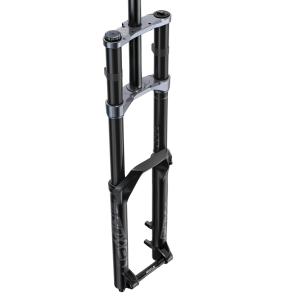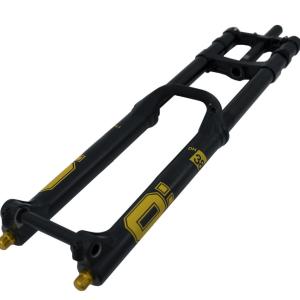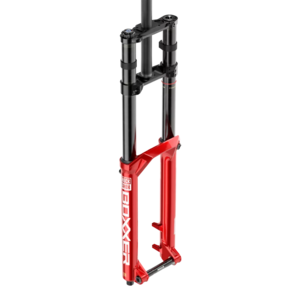Manitou Dorado Expert (2013) Fork
(discontinued)
| Where To Buy | |||
|---|---|---|---|
Free Delivery on purchases over £20.
|
|||
Free shipping on orders over $50 (continental U.S. only).
International shipping available. Some exclusions apply. |
|||
Free shipping on orders over $50 (continental U.S. only).
International shipping available. Some exclusions apply. |
|||
Review by Sean “Griz” McClendon // Photos by Brandon Turman
Manitou has been in the mountain bike suspension game for over 20-years. During the last decade, Hayes Bicycle Group (now Hayes Components) acquired Manitou, and in 2010, under new ownership, Manitou launched a completely redesigned version of the Dorado. Boasting larger stanchions, an improved chassis, new internals, and a new air system, the latest design has improved across the board.
When first reintroduced, the 2010 Dorado was only available in the uber expensive carbon variety. Later in the year they released an aluminum Dorado Pro version at $1600. Now for 2013, Manitou is introducing an even more affordable Dorado Expert at $1200. While there are some slight differences between the Pro and Expert, the internals are exactly the same, making the Expert well worth a look. With its inverted design and proven TPC+ damping, we were eager to get our hands on one to put through a good thrashing.

Dorado Expert Highlights
- 6.82-pounds (3096 grams)
- 180 or 203mm of internally adjustable travel
- Large volume air spring
- Externally adjustable high-speed, TPC+, and rebound damping
- Hydraulic bottom-out and top-out control
- 36mm stanchion tubes
- 1 1/8-inch aluminum steerer
- HexLock 20mm thru-axle
- 567 or 591mm axle-to-crown height
- Short or tall crown options
- MSRP $1,200 USD
Dorado Expert Vs. Pro
So what's different between the Dorado Expert and Pro? From a distance, you'd be hard pressed to tell which fork was which. For starters, the crowns and dropouts on the Expert are shot peened instead of anodized - result: a little less bling. Next, the crowns on the Expert undergo less machining, which leaves more material - result: a little more weight. Finally, the aluminum used in the outer tubes of the Expert is a lower grade, which means the walls had to be thickened slightly to achieve the same strength - result: again, more weight. All said and done, the total weight gain is 0.27 pounds (122.3 grams). For the $400 you save, you could easily purchase a titanium spring for your rear shock and save more total weight. Not bad.
As we mentioned before, the two forks are identical internally. The Dorado uses a twin tube style cartridge, which essentially means that air can't go into the damping circuits, keeping them free of gas bubbles and allowing damping to stay consistent.

Speaking of damping, there are four different types of compression damping circuits in the fork. The first is the spring-loaded, pressure dependent high-speed circuit. The second and third types both result from Manitou's TPC+ damping. There's a second piston on compression assembly that moves back and forth a little bit with a bypass to the high-speed circuit. Slow compressions don't fully engage the TPC+ circuit, and neither do small square edge hits. This keeps the fork supple. When the fork experiences a high enough velocity for a long enough stroke duration, the TPC+ circuit closes the high-speed bypass, engaging a second shim stack and making the damping firmer. Manitou calls this energy dependent. At the same time, a tapered needle in the TPC+ circuit makes it velocity dependent as well. The fourth damping circuit is position dependent and comes in the form of the hydraulic bottom out, which only responds when the fork is deep in its travel.
It all sounds complicated, and it is, but the end result is a fork that is suited to a wide variety of terrain conditions without fiddling with adjustments too much.
For 2013, both forks will be available in 26-inch, 650B, and 29-inch wheelsize options. Note that while it's possible to use the 26-inch fork with a 650B wheel, the outer legs on the 650B model will be unique to the wheelsize. The internals are the same between both the 26-inch and 650B forks.
Now then, how does it ride?
On The Trail
We ran the Dorado in the 203mm travel setting for the duration of testing. In this travel setting, the axle to crown length is 591mm – that's 20mm longer than the FOX 40 we swapped out - so the first thing we did was toss in a zero-stack lower headset cup in our Pivot Phoenix test sled. Even with the zero-stack cup, our head angle raked out to 63.5º from 64º. The next step was to get a lower rise bar. We opted for the low-rise Deity Black Label bar and Fantom stem in the 55mm setting. This combo of low-rise bar and 5mm longer stem provided a similar cockpit feel to the FOX 40 it replaced.

During installation, we noticed that Manitou was thorough in torque spec guidance and even includes a spacer in the lower crown to optimize clamp force. This is important because it ensures the clamping force around the legs isn't too tight, restricting the movement of the fork. Smart.
Manitou states the Dorado has a 20-hour break in period. During this time we ran the damper settings more open with a higher air pressure. As the damping felt juicier, we settled into an air pressure of 70psi for a geared rider weight of 175-pounds, 8/20 clicks of rebound, 10/20 clicks on the TPC+ dial, and 12/16 clicks of high-speed compression. At those settings, the Dorado has a very nice bottomless feel. Spiking is a suspension symptom we never found with the Dorado.

We found that the TPC+ damping plays a huge role in the way the fork performs in various conditions. For jumping we would ramp up the TPC+ dial to 18/20 clicks and in wet conditions we’d back the TPC+ down to 8/20 clicks for added front wheel traction and small bump compliance. Regardless of the TPC+ setting, the fork is supple, plush, and asks to be ridden intensely.
Coming from the super rigid FOX 40, it took several weeks to develop the confidence it took to start smashing the front wheel into compressions on steep terrain. Why? Because there's a noticeable bit of flex to this fork. In contrast to the FOX 40, we noticed less fatigue on the upper body – primarily the shoulders – thanks to the force deflection that comes with an inverted fork. It is no coincidence motocross bikes utilize inverted forks. A degree of flex translates into force deflection. In the Dorado’s case, this small degree of flex translates into less force into rider hands, arms and joints with increased front wheel traction – the fork handles more of the work for you.
That said, the Dorado still gave incredible feedback on off-camber lines with rocky and rooted compressions. In this scenario the last thing you want is for your front wheel to deflect and throw you off line and the Dorado still excelled in this situation. We loved how you could aim your front wheel into the nastiest technical lines with precision.
Having heard a lot of complaints from heavier, World Cup pace riders about a reported “wallowing” feel, we're of the opinion that riders under 185-pounds will experience optimum benefit from the inverted design. We’re coming from a lighter point-of-view and attest to the benefit of the Dorado’s force deflection in our GoPro footage. We left a few whips out with zero high-sides. We were straightened out every time and loved this about the Dorado. If you do weigh more than 185-pounds and aren’t riding at World Cup pace, you won’t push the fork to the point of a “wallowing” feel and will also reap the benefits of minimal front tire deflection. Logan Binggeli rode a Dorado to 3rd place at Rampage in 2012, so we also know it can perform in the most dangerous discipline in mountain biking, too.
Things That Could Be Improved
One thing that could use some attention is the axle system.

Manitou’s HexLock axle requires attention to detail, a fair bit of effort when removing the front wheel, and even more attention when installing it. The axle is not self-extracting and you'll need tools to remove it, so we recommend keeping the axle well lubricated – white lithium grease worked well and it’s cheap at your local shop - to ease the task of extraction and installation. Whatever the solution is to maintain structural integrity with a self-extracting axle would be greatly appreciated.
If you run your front brake on the right-hand side, the stock front brake cable routing guide is perfect. If you run your front brake on the left-hand side, American style, the routing leaves a bit to be desired.
Long Term Durability
In general it's a solid package, but we did have one issue early on. After riding in varied conditions for a few months, some of which were muddy, we ended up blowing the damper side dust seal. We continued to ride the fork for several more riders as oil continued to leak. Manitou was quick to respond and sent out a replacement damper leg that has performed flawlessly in 30-hours of ride time.

Could this have been a fluke? It's certainly possible. We weren’t able to cause any terminal damage to the Dorado and Manitou backs their products with an excellent service package, so keep that in mind as well.
After 90-hours of ride time we were able to get the rear brake cable to wear on the anodizing of the lower crown, but it was nothing to cry about. A little tape, vinyl or Velcro solves this issue.
Finally, one quick tip that could save you a headache - be sure to snug the small bolts on the fork guards often, or consider adding Loc-Tite to the threads for a set and forget solution.

What’s The Bottom Line?
We're impressed with the wide range of adjustments in damping, rebound control, and overall performance of the Dorado Expert. At $1200 and 6.82-pounds, the Dorado Expert has a very high price point to performance ratio for a downhill fork. With its proven TPC+ damping, the Dorado is supple through chatter, plush yet supportive through high-speed compressions, and offers Velcro-like traction that certainly stands out in technical off-camber situations. Complete with a limited warranty, impressive service package, and a detailed owner's manual, it's certainly a fork to consider, especially if you weigh less than 185-pounds.
Manitou plans on attending the 2013 Sea Otter Classic and several ProGRT events for you national racers looking for tech support. Check them out at the races or www.manitoumtb.com.
2 member reviews
I picked this fork up as a replacement for a 2013 Boxxer World Cup that I just wasn't getting along with. The Boxxer felt notchy and generally quite bad, even after a rebuild. It simply didn't soak up a lot of smaller chatter, leaving my arms like jello at the end of a long day.
After considering one of the newer Boxxers or a Marzocchi 380, I ended up deciding to go with the Dorado Expert. The price was right, the damping had an excellent reputation, and as a 170lb rider, I didn't think the stiffness concerns with an inverted fork would be a problem.
I have now had the fork for about a month, just getting back from my first day at Whistler this past weekend. The fork blew me away with its sensitivity and composure on gnarly trails, and the air spring honestly felt more coil-like than any other air spring I can remember using (including Fox, Rockshox, Marzocchi, etc). The stock damping recommendations were spot on from Manitou, and the setup manual was exceptionally helpful in getting the fork to a good place with minimal fiddling. The hydraulic bottom out functionality is also brilliant - it allows for a very smooth ramp up that really gives the fork a capable feel on burly trails. Initial seal tightness meant that I had to run slightly lower than recommended air pressure at the outset, but it has since broken in very nicely.
Another surprising aspect was the stiffness. While I suspect a lot of it may be speculation around the inverted design, many of the forum posts I read about the fork had questions about stiffness. While its certainly no Fox 40 in terms of stiffness, it really isn't noticeably different than my old Boxxer. Maybe I would have noticed if I weighed more than my 170 lbs, but it really didn't feel any less stiff. If anything, I think the slight give in the chassis was a bit helpful, keeping me from glancing off of every rock while blasting through loose rocks or technical steeps. Oh, and the increase in weight over the Boxxer? Couldn't notice it at all on the trail.
My only complaints are around the troublesome crown offset and long A-C length. I had to find a 55mm stem to get the bars to clear the stanchions while also achieving the stack height I was looking for, and Answer's own -One stem had compatibility issues that required that I return it. Now running a Deity Locust that fits perfectly.
Time will tell how the durability is, but Hayes service has a great reputation so I have faith that I'll be covered should anything come up. Overall, very satisfied.
6 comments
Post a reply to: Optimal Shreddability
You've all read the reviews, and know the specifics on how the internals work exactly, but what's arguably most important is how it rides. Unlike other traditional forks that have predictable characteristics based on specific settings, the Dorado operates with a dynamic feel that, in a word, just "Does"...
It doesn't take precise adjusting to get the fork to provide excellent feedback, it is a very forgiving fork that has to be exceptionally far from the correct settings, (For rider weight and terrain), to not be likable. No other fork has come close, in our years of experience. Now, that said, there are many, many forks that are excellent in their own right, each potentially excelling in certain aspects, (Lightest weight, highest torsional stiffest, etc..), but the proof is evident around here at least. Not one rider in over 20 of some of the most exceptional DH/FR guys here in the SoCal area have ever gone with another fork after using the Dorado-Not one. Many have been given other forks for promo or through industry hook up deals over the years, and not a single one has not put their Dorado back on.
That speaks for itself. Give the Dorado a try if you haven't yet, chances are, you'll never look back!
1 comments
Post a reply to: Best triple crown fork out there-hands down!
Specifications
| Where To Buy | |||
|---|---|---|---|
Free Delivery on purchases over £20.
|
|||
Free shipping on orders over $50 (continental U.S. only).
International shipping available. Some exclusions apply. |
|||
Free shipping on orders over $50 (continental U.S. only).
International shipping available. Some exclusions apply. |
|||


























11 comments
Post a reply to: Tested: Manitou Dorado Expert - A Worthy Contender